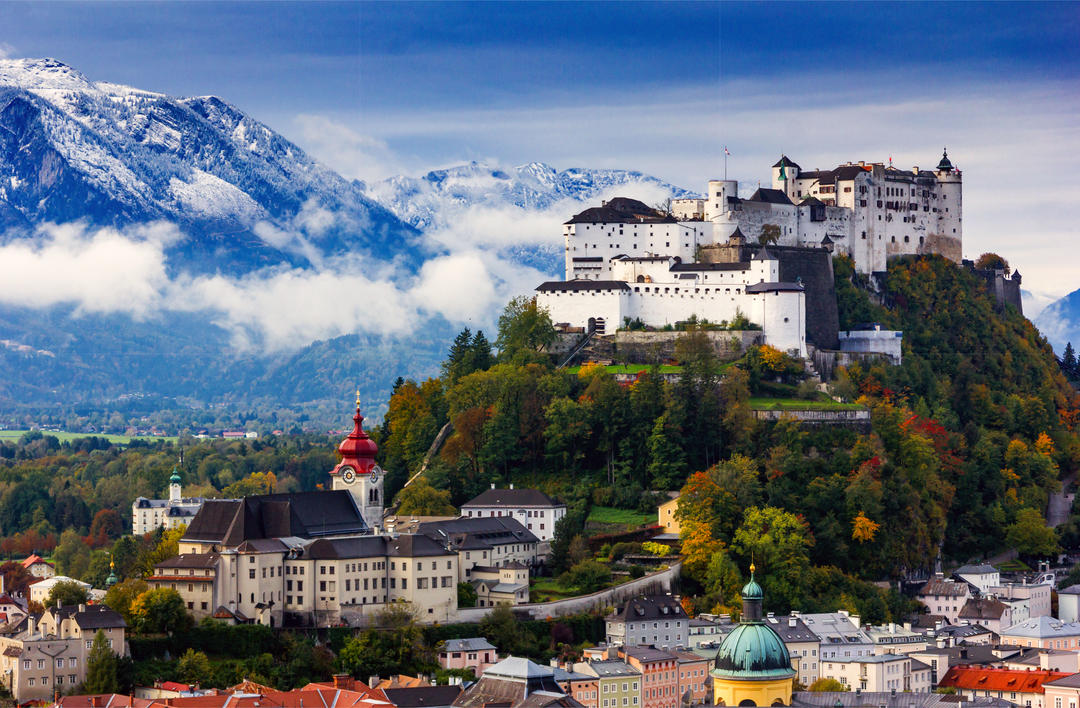Hohensalzburg Castle
Just imagine, in Austria, the medieval castle Hohensalzburg has been preserved almost unchanged, and it is one of the largest in Europe. The incomparable pleasure of a panoramic view of Salzburg, mountains and endless valleys, opening from the towers and terrace of the castle, awaits guests without fail.
The date of foundation is 1077. The castle was built at the behest of Gebhard the First (bishop). Initially, Hohensalzburg was built in the Romanesque style, and then it was rebuilt and strengthened, giving a new look – a powerful fortress that served as a stronghold for Gebhard the First. The dimensions that the castle has in our time, it acquired by the 16th century. The total area of the premises is 30,000 m², the length of the castle was 250 meters, and the width is slightly less – 150.
The mines located in the Alps became the direct “sponsors” of the construction of the fortress. In them, at that time, 1/3 of the gold in the world was mined. The same miners decided to capture the fortress (the only siege in the entire existence), rebelling against the bishops.
One legend about a bull is associated with this episode. The food supply in the castle was small, exhausted after a few days from the beginning of the siege. The bishop decided to take the miners by cunning. At his behest, the bull, which remained in the castle in a single copy, was decided to be painted every day in a new color, while driving around Hohensalzburg. In such an unusual way, he tried to demonstrate to the miners a non-existent food supply. And what can we say, the trick was a success, and the miners retreated from the fortress in a couple of weeks.

In Austria, you can count on the fingers of the castles that the enemies never managed to capture, and Hohensalzburg is one of them. Only during the rampage of Napoleon’s troops, it was surrendered without a fight (it is worth considering that at that time it had no military significance for the country). As a result, the castle was used as a warehouse and barracks. In the 20th century, it housed a prison with foreign prisoners of war and Nazis.
Now the castle has been completely restored, opening a museum of the Middle Ages of Austria in it. It houses exhibitions with works of art, armor, weapons and instruments of torture.
You can get acquainted with the castle already in Salzburg, where you can easily see it despite the long distance. The funicular, with which it is possible to climb to the sights, allows you to examine the stone walls, towers and the access road itself.
There are about 20 buildings directly on the territory of the castle. 8 of them are towers, a church, a prison, a gate, a firehouse, a well and even a bakery! The Kraut Tower houses a mechanical organ dating back to the 16th century. In the chapel, the paintings on the vaults are interesting, coupled with amazing bas-reliefs made of snow-white marble. The medieval interior, preserved in the Princes’ Chambers, will make you feel like you are in a different era.
Concerts are organized inside the castle, artists gather here during the summer months for the International Academy.
The largest medieval fortress
Fortress Hohensalzburg is considered one of the largest medieval fortresses in Europe. It was finally completed by the 16th century on top of the 120-meter Festung mountain, where today you can climb by funicular or on foot.

At one time, the fortress was repeatedly subjected to severe sieges. There is a legend according to which the peasants, who disagreed with the established order, gathered to starve the archbishop, who lived in Hohensalzburg. As a result, the food supplies of the besieged were almost over – only one bull remained.
Then the archbishop went to the trick. The wool of the bull was dyed daily in different colors, and then the animal was released to graze near the fortress walls. The villagers decided that the authorities were not dying of hunger at all, and stopped the siege. Later, the fortress was used as a barracks and warehouses, and in the last century Italian prisoners of war and Nazis were imprisoned there.
Today, Hohensalzburg is the main attraction of Salzburg, which can be seen from almost anywhere in the city. Spacious rooms and towers are open to the public all year round, and within the walls of the fortress there is a museum with exhibits telling about the life of the city and the military history of Austria.
